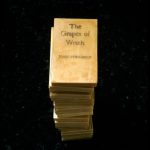O R I G I N A N D M Y T H S O F F I R E : N E W A R T F R O M J A P A N , C H I N A A N D K O R E A, The Museum of Modern Art, Saitama, Saitama, Japan, 1996
Curator: Makoto Nakamura
Organizer: The Museum of Modern Art, Saitama, Asahi Daily News
In coorperation with: Japan Airline, Shiseido Co., Ltd.
wax, coal, library card catalogue, picture frame
This installation is based on Nagasawa’s research of the history of book burning. Examples of the investigations include the emperor Chi Huang Ti, who disapproved the traditional culture of China in 213 B.C. Wishing to abolish the feudal system, he burned the “Analects” (the sayings of Confucius and his Disciples) and all extant books except practical works on medicine, divination, and husbandry. Similarly, in 1933, many cultures turned to ashes under a Nazi bonfire.
In a more recent incident, dating from 1993, four hundred and seventy copies of the catalogue “Art of Toyama Biennial ’86” was burned by The Museum of Modern Art of Toyama Prefecture because of a controversy involving prints of the Japanese Emperor Hirohito juxtaposed with nudity. The original prints were purchased by the museum and became their collection after the work was exhibited. However, the images of the prints became highly controversial, and the museum decided not only sell the prints, but burn their own museum catalogues.
The title Celsius 233 comes from Ray Bradbury’s novel, “Fahrenheit 451.” Fahrenheit 451 in degrees Celsius is two hundred and thirty-three, which is the temperature at which paper, and therefore books, catch fire and burn. The installation thus represents the oppression of the freedoms of thought and expression through the burning of literature. What remains after books are burned? Only the intangible thoughts and memories of people.


